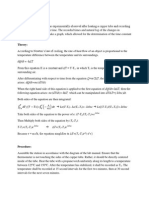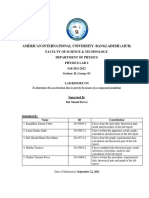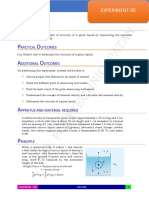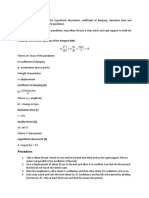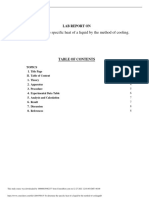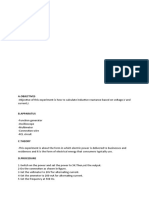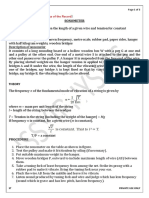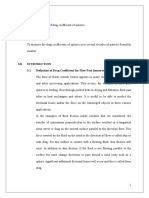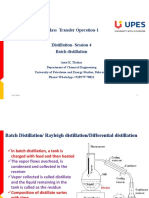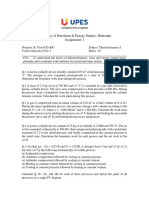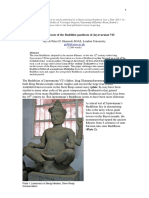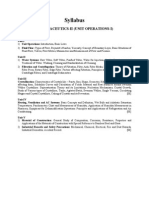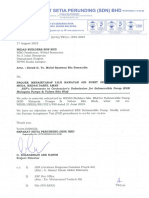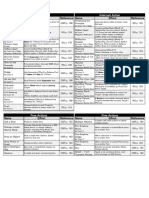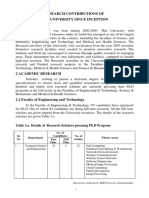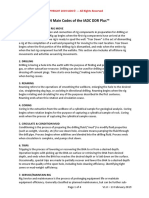Experiment 5 (Newton's Law of Cooling)
Aim
1. The aim of the experiment is to verify Newton's Law of Cooling of different materials
and different liquids.
2. To draw the cooling curve.
Theory
Temperature difference in any situation results from energy flow into a system or energy flow
from a system to surroundings. The former leads to heating, whereas latter leads to cooling of
an object.
Newton’s Law of Cooling states that the rate of temperature of the body is proportional to the
difference between the temperature of the body and that of the surrounding medium. This
statement leads to the classic equation of exponential decline over time which can be applied
to many phenomena in science and engineering, including the discharge of a capacitor and
the decay in radioactivity.
Newton's Law of Cooling is useful for studying water heating because it can tell us how fast
the hot water in pipes cools off. A practical application is that it can tell us how fast a water
heater cools down if you turn off the breaker when you go on vacation.
Suppose that a body with initial temperature T 1°C, is allowed to cool in air which is
maintained at a constant temperature T2°C.
Let the temperature of the body be T°C at time t.
Then by Newton’s Law of Cooling,
(1)
Where k is a positive proportionality constant. Since the temperature of the body is higher
than the temperature of the surroundings then T-T2 is positive. Also the temperature of the
body is decreasing i.e. it is cooling down and rate of change of temperature is negative.
The constant ‘k’ depends upon the surface properties of the material being cooled.
Initial condition is given by T=T1 at t=0
Solving (1)
�
(2)
Applying initial conditions;
Substituting the value of C in equation (2) gives
This equation represents Newton’s law of cooling.
If k <0, lim t --> ∞, e-kt = 0 and T= T2 ,
Or we can say that the temperature of the body approaches that of its surroundings as time
goes.
The graph drawn between the temperature of the body and time is known as cooling curve.
The slope of the tangent to the curve at any point gives the rate of fall of temperature.
In general,
where,
T(t) = Temperature at time t,
TA = Ambient temperature (temp of surroundings),
TH = Temperature of hot object at time 0,
�k = positive constant and
t = time.
Example of Newton's Law of Cooling:
This kind of cooling data can be measured and plotted and the results can be used to compute
the unknown parameter k. The parameter can sometimes also be derived mathematically.
Applications
1. To predict how long it takes for a hot object to cool down at a certain temperature.
2. To find the temperature of a soda placed in a refrigerator by a certain amount of time.
3. It helps to indicate the time of death given the probable body temperature at the time of
death and current body temperature.
�Procedure:
This is the experimental set up that the user can see on the simulator.
User Instructions
The simulator consists of three regions:
1. Simulator’s viewable window.
2. Variable menu.
3. Measurement menu.
Variable Menu:
The variable menu contains two drop down combo boxes and two buttons. The user can
select the desired material and liquid from these combo boxes. Here select the material (say
'Brass') and liquid (say 'Water'), then click on the Start Heating button. The temperature starts
rising. When it reaches the desired temperature (say 80oC) click on the Stop Heating button.
�When the temperature falls to 70oC, start the stop watch. The time reading is taken for every
5o fall of temperature. The user can click on the 'Show Graph' checkbox to see a graph that is
initially blank. To plot the graph, click on the Plot Graph button. The graph is plotted by
noting the temperature along the Y axis and time along the X axis.
The graph is shown below. The next is the reset button. It resets the simulator to its default
values.
Example :
The user can repeat the experiment to change the material, liquid and temperature TH.
�
The values entered in both variable menu and measurement menu are default values. The user
can do the experiment using different options by selecting the corresponding icons.
Measurement Menu:
In the measurement menu the user can view the measured temperature reading and the time
for cooling.
Procedure for Real lab
The calorie meter is filled 2/3rd with the given liquid and is heated to a temperature of 80 oC.
This liquid will act as a hot body which is subjected to cooling. The thermometer is inserted
in to the calorimeter. When the temperature reading is 70oC the stopwatch is started. The time
readings are noted for every 5o fall of temperature up to the room temperature. The readings
are tabulated. A graph is drawn with temperature θ along Y axis and time (t) along X axis,
dθ/dt is found by taking slopes to tangents drawn at various temperatures on the cooling
curve. Hence Newton's law of cooling is verified.
Observations and Calculations
Time (s) Temperature (0C)
Slope dθ/dt = .............................
�Result
Newton's Law of Cooling is verified.
